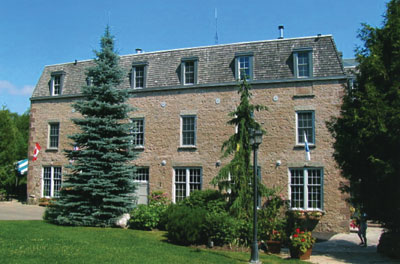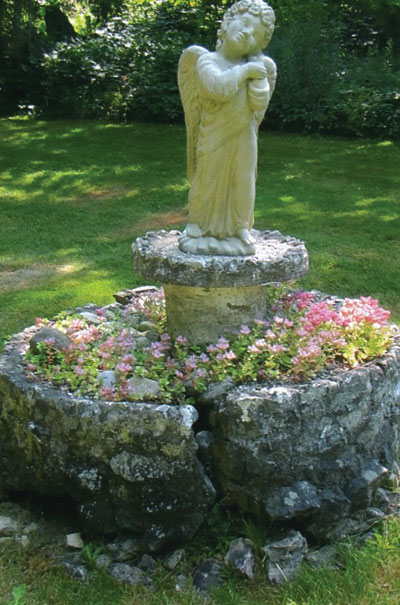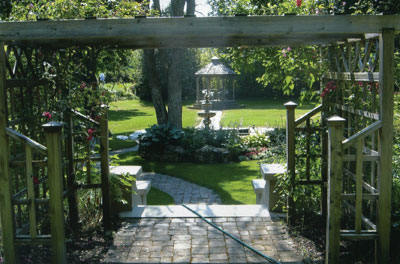
Sandra MacAvelia is the Indiana Jones of the horticultural world.
Sandra MacAvelia is the Indiana Jones of the horticultural world. The gardener at Millcroft Inn and Spa in Alton, Ont., is engaged in landscape archeology, unearthing and painstakingly restoring long-buried and forgotten Victorian-era garden features. Her dream is to bring the gardens back to a state as they would have looked a century ago. For a gardener, her quest is inspiring.
 |
|
| There’s a revival underway at Millcroft Inn and Spa, where Sandra MacAvelia is restoring the Victorian gardens to their former glory. Advertisement
|
“When I find an original garden feature it’s like discovering a relic or some lost treasure,” the self-taught gardener says with excitement. “I realize I’m looking at history, something tangible that dates back to the time of the original owners. It’s another example of the history that surrounds us here.”
Huddled along the banks of soothing Shaw’s Creek, the Millcroft Inn and Spa exemplifies classic country charm, but this pretty resort was once a bustling industrial hub. From the 1880s to the 1960s, it was one of the leading knitting mills in all of Canada, manufacturing all manner of woolen garments that were shipped across the country and overseas. Today it’s a four diamond resort, which consists of a collection of century-old buildings that have retained much of their original appearance and charm. It’s apparent from the moment you arrive that this place in rich in history.
 |
|
| This Victorian-inspired angel statue tops a restored concrete statuary base. |
A visitor’s attention is naturally drawn to the former mill itself, which houses the inn’s main lobby, a fine-dining restaurant, and guestrooms, the handsome stone warehouse that today houses the inn’s conference centre, and the manor house, which was once the private residence of mill owner John M. Dods and his family. These painstakingly preserved heritage structures so dominate the landscape that few people ever stopped to consider what history may be found lying dormant in the gardens.
“I decided I wanted to move a gazebo one day. When I did I found it had been built over top of a majestic century-old fountain. I was ecstatic! No one else could understand my excitement but I knew the value of what I’d found. It’s a piece of the past,” says MacAvelia. “I decided the fountain had to be restored to working order. It was still in remarkable condition, but I did have to add a liner because the stone had deteriorated so much it would no longer hold water. Otherwise, as you see it today is how it would have looked 100 years ago.”
That discovery prompted MacAvelia’s quest to restore the remainder of the formal, Victorian gardens that she knew surely existed in the shadow of the manor home and around the fountain. Uncovering the features, buried under decades of less sensitive landscaping and in some cases overgrowth, would take time that, for MacAvelia, is at a premium.
“I’m a one woman show here, and it takes an hour just to water all the pots every day,” she laughs.
 |
|
| Walkways wind past statuary and flower beds that date back over a century.
|
Concrete steps leading down to the gardens from the elevated manor home were restored and beautified with the addition of a vine-laced pergola and showy flowers. It’s no mistake that descending these steps will take you to a warm, welcoming floral world. A rock wall garden leading off from the left side of the stairs was pains-takingly brought back to life. MacAvelia
subsequently built another rock wall garden to the right to balance it out and make the garden flow. Like the original landscaper, she used only limestone rocks indigenous to the area.
“I found another fountain under the shade of a large tree. The iron pipe that fed the fountain was still there, as was the rock wall that would have held the water. I stabilized the wall but it wasn’t possible to make it functional again. Instead, I incorporated it into garden as a focal point, adding hostas and statuary,” she explains as she guides me around the property.
Elsewhere, MacAvelia has unearthed walkways, a concrete statuary base (upon which she has placed a Victorian-style angel statue), and old flower beds containing lilies of the valley, tulips, roses and primulas that date back a century. Each new discovery brings MacAvelia and her beloved gardens one step closer to the 1890s when John Dods resided here and presided over his milling empire.
What’s next for MacAvelia’s incredible restoration project?
“The original, overgrown driveway runs along the east side of the manor home, and beside it are ancient hydrangeas, and roses, and other flowerings shrubs. I’d love to bring those gardens back to life,” she says, though hastily adding she has no idea where she would find the time in her already full days.
Over the past years, MacAvelia has turned back the clock by restoring the Millcroft’s Victorian-era garden. Lush borders, elegant water features and statuary and colourful beds have risen once more, re-creating a delightful sensory destination that enchanted the Dods family and their friends more than a century ago. That connection to the past makes visiting the Millcroft a truly memorable and, for gardening aficionados, inspiring experience.
| Networking with Local Resorts There’s a myth out there that if you build an esthetically pleasing garden centre, staff it with brilliant horticulturalists and salespeople, and stock it with the best range of plants, the parking lot will be filled with cars and very little promotion will be necessary. That’s simply not true. Success boils down to building relationships and to word of mouth. As a result, networking with local resorts, inns or even a bed-and-breakfast in the vicinity can be a boon for any garden centre. ”Teach a person to garden and they become a loyal customer,” is an oft repeated mantra in the industry. The problem is that garden classes taught at the store clog up the parking lot and suck up staffing resources. Local resorts can be the solution to this challenge, because they have the facilities to host events. Offer to teach a garden class around which the property can build a day-package (lunch, the gardening class, and perhaps, in the case of a historic property, a brief tour) and promote it at your garden centre through your website, e-newsletter, posters and word of mouth. Everyone wins: the resort gets a large group for lunch, customers enjoy a wonderful afternoon, and you’ve laid the foundations for a relationship that may well see the resort patronize your centre for its gardening needs. There are numerous other ways to find synergy with local inns. For example, many host doors-open days, charitable events and holiday functions. Offer the use of some unique décor or a fully dressed Christmas tree on the condition that your centre’s involvement be prominently noted. You’ll be surprised at the goodwill from property management and the community that this will reward you with in return. The point is to find ways to get involved and to network with your local resort or inn. A lasting business relationship will benefit both parties, and the word-of-mouth exposure you’re sure to gain will be well worth the effort you invest. |
Print this page